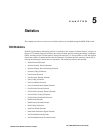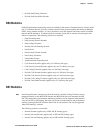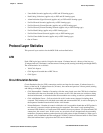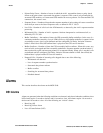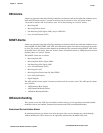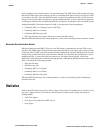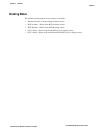
5-4
Cisco MGX 8240 Hardware User’s Guide
Release 3.0, Part Number 78-10728-01, July 2000
Chapter 5 Statistics
Alarms
• Pointer Parity Errors—Number of events in which the AAL1 reassembler detects a parity check
failure at the point where a structured data pointer is expected. This count is only meaningful for
structured CES modules, as Unstructured CES modules do not use pointers. For Unstructured CES
connections, this count is zero.
• Sequence Errors—Number of times that the sequence number of an incoming cell causes a transition
from the Sync state to the Out of Sequence state, as defined in ITU-T I.363.1
• Lost Cells—Number of cells lost in the ATM network, as detected by the AAL1 sequence number
processing.
• Misinserted Cells—Number of AAL1 sequence violations interpreted as a misinserted cell, as
defined by ITU-T I.363.1
• Buffer Underflows —the number of times the CES reassembly buffer underflows. In the case of a
continuous underflow caused by a loss of ATM cell flow, a single buffer underflow is counted. After
an underflow occurs, data is again buffered until the configured Cell Delay Variation Tolerance
buffer is filled. Once filled, the buffered data is played out the CES service interface.
• Buffer Overflows—Number of times the CES reassembly buffer overflows. When this occurs, any
received cells are dropped until the reassembly underflows. Sequence number synchronization is
then searched for again (and structure pointers if in structured mode). When sync is reached, cells
are buffered until the configured Cell Delay Variation Tolerance buffer is filled. Once filled, the
buffered data is played out the CES service interface.
• Dropped Cells—Number of incoming cells dropped due to one of the following:
–
Misinserted cell detected
–
Loss of sequence number synchronization
–
Structured data pointer reframe
–
Buffer overflow
–
Searching for structured data pointer
–
Disabled channel
Alarms
This section describes the alarms on the MGX 8240.
DS1 Alarms
Alarms are generated when the following conditions are detected, and cleared when the conditions clear.
LOF alarms require 2 seconds to declare and 16 seconds to clear. AIS alarms require 1.6 seconds to
declare and 10 seconds to clear. All of the following are “critical” alarms.
• Receiving AIS
• Receiving Yellow Alarm
• Loss of Frame Pointer (LOF)



